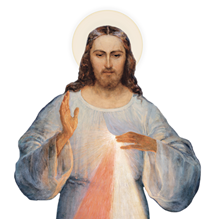
Here's an excerpt from Fr. Michael Gaitley, MIC's 33 Days to Morning Glory in honor of the anniversary of Our Lady giving us the gift of the miraculous medal.
Like the scapular, the miraculous medal is a sacramental. It originates from an apparition of Mary to St. Catherine Labouré, a French nun, living in Paris. The specific apparition that has to do with the miraculous medal occurred on November 27, 1830.
In that vision of November 27, St. Catherine saw Mary standing on a half-globe with a serpent crushed beneath her feet and her hands bejeweled with rings, holding a small golden globe with a cross on it. Bright light shown from some of the jewels on her fingers. Suddenly, the small, golden globe disappeared from Mary's hands, and she opened her arms outward. The light from the jewels extended out from her hands, and a semi-circle frame appeared around and over her with an inscription in gold: "O Mary, conceived without sin, pray for us who have recourse to thee."
The vision seemed to rotate, and on the reverse side, Catherine saw the letter "M" with a cross on it and surrounded by twelve stars. The cross stood on a horizontal bar. Under the "M" were two hearts engulfed in flames, one encircled in thorns and the other pierced by a sword.
Mary then told Catherine, "Have a medal struck upon this model. Those who wear it will receive great graces, especially if they wear it around the neck."
Mary explained the meaning of the medal to Catherine as follows: Mary is Queen of heaven and earth. She crushes Satan, who is helpless before her, under her foot (see Gen 3:15). Her arms are open, and the many rays of light are graces that she obtains for those who request them. The dark jewels, the ones that are not full of light, represent the graces that are available but that people don't receive because they don't ask for them.
The inscription, "O Mary, conceived without sin, pray for us who have recourse to thee," refers to Mary's Immaculate Conception, which means that from the first moment of her conception she was free from all stain of original sin.
On the back of the medal, the twelve stars represent the twelve Apostles, who represent the whole Church, which surrounds Mary. The "M" is for Mary, and the cross is the Cross of Christ, the symbol of our redemption. The horizontal bar represents the earth. The placement of the cross and the bar on and in the letter "M" shows Mary's participation in the Cross of Christ and her involvement in our world. The two hearts are those of Jesus and Mary, burning with love for us all.
With the Church's approval, the first "Medals of the Immaculate Conception" were made in 1832, and almost immediately, reports of miraculous cures began to spring up, so much so that the medal became known as the "miraculous medal."
Since the time of the apparitions, millions of medals have been distributed around the world, especially by people like Blessed Mother Teresa of Calcutta. It's reported that her Missionaries of Charity currently distribute 1.8 million medals per year.
The miraculous medal received liturgical approbation (special recognition and approval for public prayer) at the direction of Aloisi Cardinal Masella, Prefect of the Sacred Congregation of Rites, in 1895. It's one of only three sacramentals in the Church to be so liturgically honored, sharing this distinction with the Rosary and the brown scapular.
Far from being a good luck charm or superstition, powerful conversions have taken place through Mary's intercession and the use of the miraculous medal.
One of the most famous conversions happened to Alphonse Ratisbonne, a Jewish atheist, on January 20, 1842. He despised the Church and the Catholic faith, especially since his older brother, Theodor, converted to Catholicism and became a Catholic priest. On a dare from a Catholic friend, Baron de Bussieres, Ratisbonne began to wear the miraculous medal and to recite the Memorare prayer to prove the fruitlessness of what he thought were just the ridiculous superstitions of the Catholic religion.
On January 20th, Ratisbonne accompanied Baron de Bussieres into a church, what is now the Basilica of St. Andrea delle Fratte in Rome, where the Baron had some business to attend to. When the Baron returned to him, he found Ratisbonne weeping and kissing his medal saying, "I saw her! I saw her!"
Ratisbonne later recounted what happened in his diary:
I had only been in the church a moment when I was suddenly seized with an indescribable agitation of mind. I looked up and found that the rest of the building had disappeared. One single chapel seemed to have gathered all the light and concentrated it in itself. In the midst of this radiance I saw someone standing on the altar, a lofty shining figure, all majesty and sweetness, the Virgin Mary just as she looks on this medal. Some irresistible force drew me towards her. She motioned to me to kneel down and when I did so, she seemed to approve. Though she never said a word, I understood her perfectly.
This encounter with Mary so profoundly affected Ratisbonne that he converted to Catholicism and was ordained a priest in 1847. He later moved to the Holy Land with his brother Theodor and founded a congregation of sisters - the Congregation of Our Lady of Sion - to pray for the conversion of the Jews.
An image of Mary as she appeared to Ratisbonne was painted a few months after the apparition and then hung above the altar in the church where Ratisbonne saw her. Later, another devotee of Mary and the miraculous medal, St. Maximilian Kolbe, celebrated his first Mass in the same church in Rome, before the same painting. Apparently, in January of 1917, while he was still a seminarian in Rome, Kolbe had heard a talk on the conversion of Ratisbonne. He continued to meditate on Mary's intercession for this non-believer, for nine months.
In October of the same year, Kolbe began the Militia Immaculata (MI) with six other Franciscans. These young men consecrated their lives totally and unconditionally to Mary for the sake of their own sanctification and the conversion of souls. All members of the MI now wear the miraculous medal as a sign of their total consecration to Mary and distribute it so that Mary may work wonders of grace in the lives of others.
Of the miraculous medal, Kolbe stated:
Even though a person be the worst sort, if only he agrees to wear the medal, give it to him ... and then pray for him, and at the proper moment strive to bring him closer to his Immaculate Mother, so that he have recourse to her in all difficulties and temptation.
Wearing the miraculous medal is a discreet, simple, and effective way to express one's devotion and consecration to Mary, and it disposes us to receive God's grace through her powerful intercession.
We encourage everyone to get a miraculous medal, have it blessed by a priest, and wear it, trusting in the motherly love and intercession of the Blessed Virgin Mary.

















